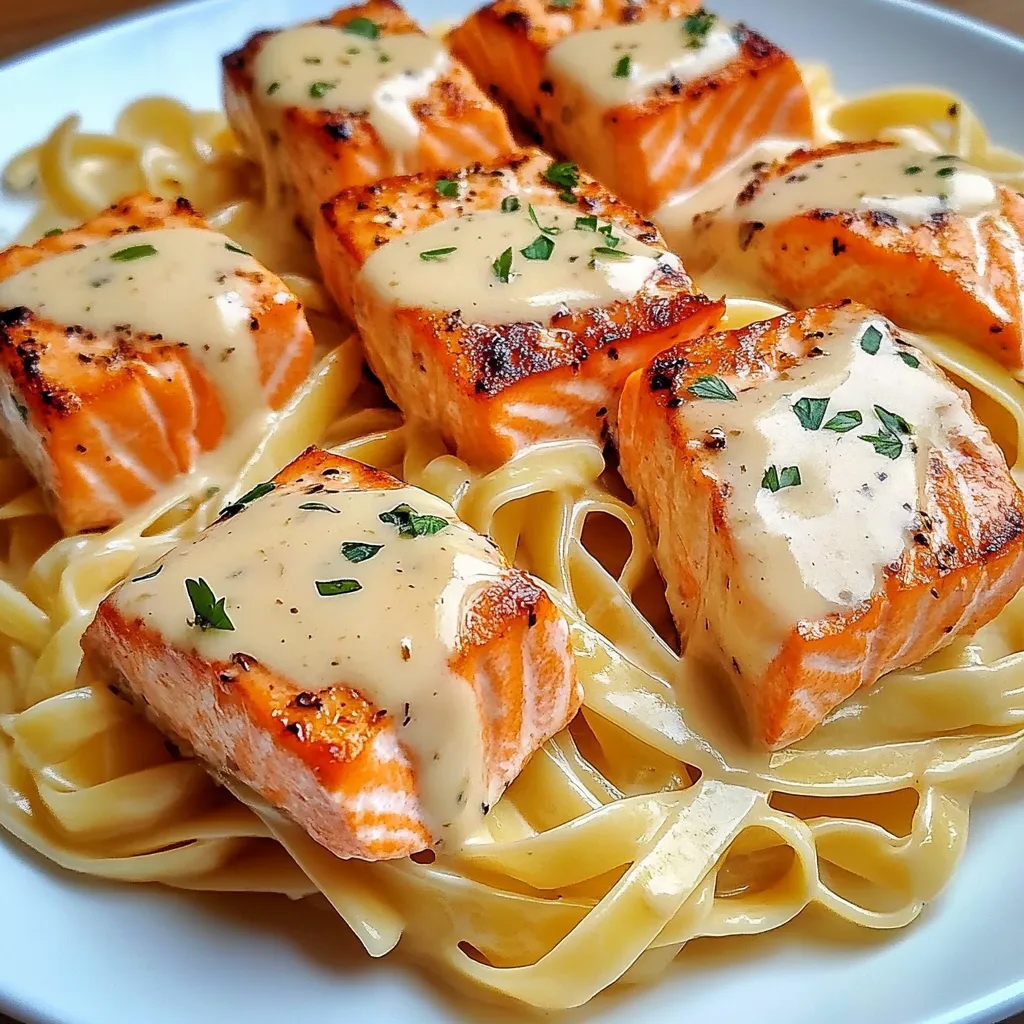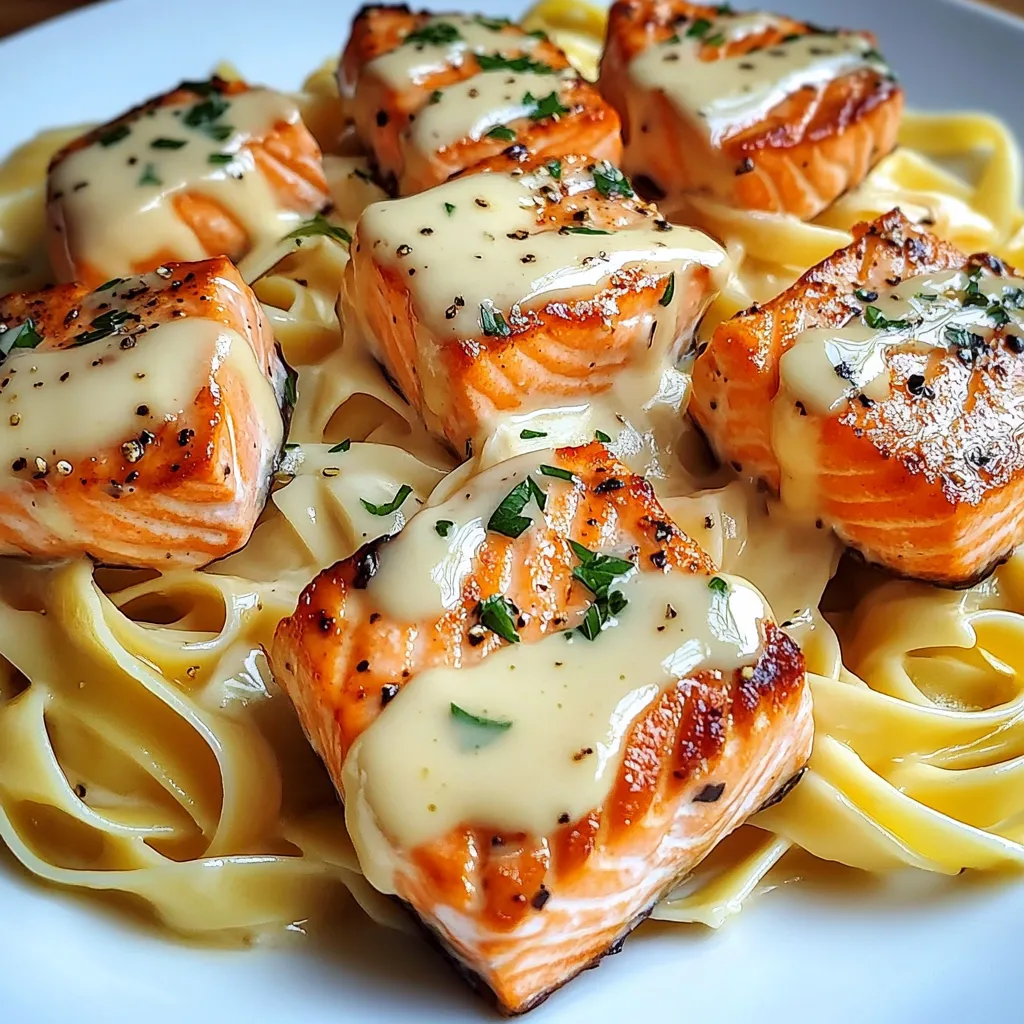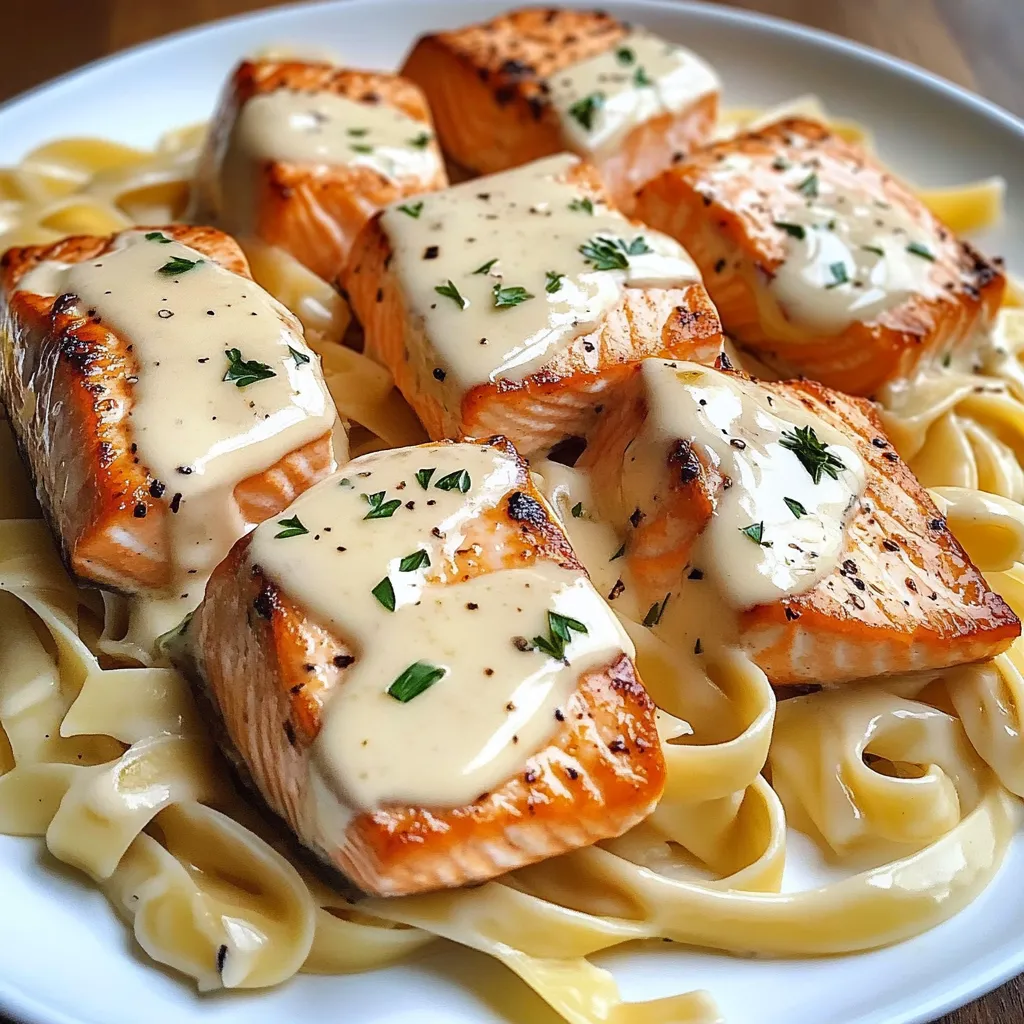 Save
Save
Silky sauce envelops tender pasta and crispy-edged salmon in this extraordinary weeknight indulgence. This remarkable combination transforms everyday ingredients into restaurant-worthy elegance with minimal effort and maximum impact. The contrast between perfectly seared salmon and velvety cream sauce creates textural harmony in every forkful. Fresh herbs and bright lemon notes cut through the richness, preventing heaviness while adding depth that keeps each bite interesting from first taste to last.
The inspiration for this dish struck during a particularly demanding week when elegant dining seemed impossible yet desperately needed. The combination of pantry staples with fresh salmon yielded results far exceeding expectations, creating an almost magical dining experience. My typically reserved dinner guest, who rarely comments on meals, immediately requested the recipe while reaching for seconds. Something about this particular balance of flavors creates instant contentment that transcends ordinary pasta dishes.
Perfect Ingredients
- Fresh salmon fillets: Form the protein-rich centerpiece with beautiful color and texture. Wild-caught varieties offer superior flavor though farm-raised works beautifully too.
- Fettuccine pasta: Creates the ideal vehicle for capturing creamy sauce. The flat, ribbon-like shape holds sauce beautifully compared to smaller pasta varieties.
- Heavy cream: Provides luxurious base for the signature sauce. Full-fat version produces significantly superior results to lighter alternatives.
- Parmesan cheese: Adds savory depth with natural thickening properties. Freshly grated delivers dramatically better flavor and texture than pre-packaged versions.
- Fresh garlic: Forms aromatic foundation for the entire dish. Mince finely rather than press for better texture and more controlled flavor release.
- Quality butter: Creates silky richness that defines the sauce. European-style butter with higher fat content offers superior flavor if available.
- Extra virgin olive oil: Facilitates perfect salmon searing without overwhelming flavor. The fruity notes complement fish beautifully.
- Fresh lemon juice: Brightens rich elements with essential acidity. Always use freshly squeezed rather than bottled for vibrant flavor.
- Red pepper flakes: Introduce gentle warmth without dominating heat. Their subtle spice balances the cream beautifully.
- Fresh parsley: Provides vibrant color and herbaceous brightness. The slight pepperiness cuts through richness perfectly.
Cooking Method
Pasta Perfection
Begin by cooking fettuccine in abundantly salted water until precisely al dente—typically one minute less than package directions suggest. This slight undercooking ensures the pasta maintains proper texture after combining with hot sauce. Reserve a small amount of starchy cooking water before draining to adjust sauce consistency later if needed. Rinse pasta only if not proceeding immediately with the recipe to prevent unnecessary cooling and starch removal.
Salmon Mastery
Season fish generously with salt and pepper on both sides, allowing seasoning to adhere properly before cooking. Heat the pan thoroughly before adding oil to create a proper searing environment. Place salmon pieces skin-side down first (if skin remains), pressing gently with a spatula to ensure full contact with the hot surface. Resist the temptation to move the fish prematurely, allowing natural release once a proper crust forms. This careful approach ensures a golden exterior while maintaining a moist, tender interior.
Sauce Creation
Utilize the same pan used for salmon to capture all developed flavor compounds. Begin the sauce with butter and fresh garlic, cooking just until fragrant without browning. Add cream in a steady stream while stirring constantly to prevent temperature shock and potential separation. Incorporate cheese gradually with gentle heat, allowing each addition to melt completely before adding more. This patience creates a silky emulsion rather than a grainy texture. The finished sauce should coat the back of a spoon while still flowing gracefully.
Perfect Integration
Combine drained pasta directly into the sauce rather than pouring sauce over pasta. This technique ensures even coating while allowing proper sauce absorption. Add reserved pasta water by tablespoonfuls only if needed to adjust consistency. Return salmon to the pan with gentle placement atop pasta, preserving its structural integrity while allowing flavors to meld. This thoughtful assembly maintains distinct components while creating a cohesive dish.
Final Touches
Finish with fresh lemon juice added off-heat to preserve bright flavor that would diminish with extended cooking. Sprinkle fresh herbs just before serving for vibrant color and aromatic lift that complements rather than competes with the dish. A final light seasoning adjustment ensures perfect flavor balance, recognizing that cheese contributes natural saltiness that develops as the dish comes together.
 Save
Save
My first attempt at this recipe taught me valuable lessons about heat management and timing. When I initially cooked salmon and pasta simultaneously, the salmon cooled too much while waiting for pasta to finish. Now I begin pasta cooking, then prepare salmon while water boils, creating perfect timing synchronization. Similarly, I discovered the importance of adding lemon juice after removing the pan from heat—direct cooking diminishes brightness while potentially curdling cream. These small adjustments transformed good results into consistently exceptional ones.
Serving Suggestions
Elevate your salmon pasta experience by serving with a simple arugula salad dressed with lemon vinaigrette for a peppery contrast to the rich main dish. Consider offering warm, crusty bread for capturing every drop of the remarkable sauce. For wine enthusiasts, chilled Pinot Grigio complements both salmon and cream elements beautifully without overwhelming more delicate flavors. During summer months, add lightly roasted asparagus or cherry tomatoes alongside for seasonal color and nutritional balance.
Creative Variations
Transform this classic by incorporating fresh spring peas or tender spinach during the final minutes for beautiful color and nutritional boost. Create a Mediterranean variation by adding halved cherry tomatoes and chopped fresh basil in place of parsley. Experiment with different pasta shapes such as pappardelle or linguine for textural variety while maintaining sauce-capturing abilities. Consider a smoked salmon alternative that eliminates the cooking step while adding a distinctive flavor dimension. For special occasions, incorporate a small amount of preserved lemon or capers for sophisticated flavor enhancement.
Storage Solutions
Maintain optimal texture by refrigerating leftovers in an airtight container for up to two days. Reheat gently in a covered skillet with a splash of cream or milk to revive sauce consistency without overcooking salmon. For make-ahead convenience, prepare the sauce completely and refrigerate separately, reheating gently before combining with freshly cooked pasta and salmon. This component separation maintains better texture than storing the fully assembled dish. Freezing the complete dish is not recommended as both sauce and fish texture suffer significantly.
 Save
Save
The journey to perfect salmon pasta taught me valuable lessons about ingredient quality and preparation. When I began using block parmesan freshly grated rather than pre-packaged versions, the sauce texture improved dramatically despite identical preparation. Similarly, discovering that slightly higher quality salmon required less handling and yielded more consistent results transformed good pasta into something truly memorable. These thoughtful ingredient selections elevated simple comfort food into elegant dining without significant additional effort.
Common Questions About Cooking
- → Can I use a different type of pasta?
- Absolutely! While fettuccine works beautifully with the creamy sauce, you can substitute with linguine, spaghetti, or even penne. Just make sure to use a pasta that holds the rich sauce well.
- → What can I substitute for heavy cream?
- For a lighter version, you can use half-and-half or whole milk mixed with 1 tablespoon of cornstarch. Coconut cream is a great dairy-free alternative that maintains the creamy texture.
- → Can I use pre-cooked or canned salmon?
- While fresh salmon creates the best texture and flavor, you can use pre-cooked salmon. Just add it at the very end to warm through without overcooking. Canned salmon works in a pinch but won't have the same texture.
- → How do I know when the salmon is perfectly cooked?
- Salmon is done when it flakes easily with a fork but is still slightly translucent in the center. For this recipe, a quick 2-3 minute sear on each side is perfect since the salmon will continue cooking slightly when added back to the hot sauce.
- → Can I make this dish ahead of time?
- This pasta is best enjoyed fresh, but you can prepare components ahead. Cook the salmon and make the sauce separately, then refrigerate. Reheat the sauce gently, cook fresh pasta, and combine just before serving with the reheated salmon on top.
